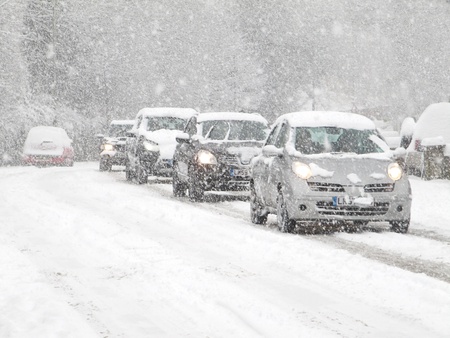In winter weather conditions, when the roads are covered with snow, it doesn’t recommend to get into a car. However, you must know what to do in this weather, because driving sometimes is unavoidable.
Driving in snow needs a different mindset. The main point is the friction, which ensures the adhesion of the rubber to the road and allows acceleration, braking control. This is much less in winter than in summer. The snow and ice makes the roads slippery, but the low temperature also affects the tires.
How to prevent accidents?
– Drive slowly
Give less gas to increase traction. Do not use cruise control and don’t try to overtake. The vehicle needs adhesion order to brakes work properly and therefore slower speeds are required. Reduce your speed at least half of the speed limit.
Accelerate much more gradually than at other times, increase the speed slowly.
– Drive gently and smoothly
Everything – steering, gas, brake – you have to use slowly. Sudden changes can cause that your tires lose adhesion. This can lead to slipping.
Manual transmission car, start driving slowly, gently press the clutch while keeping the engine at low revs. At low rpm the motor rotates slowly, which reduces the risk of skidding.
If you drive an automatic or four-wheel drive car, make sure that the rate be low. This shows a snowflake symbol or letter L on the gear lever. If available, use it. Do not use the sport mode!
Avoid from sudden maneuvers, as sharp steering or braking, they can tilt the balance of the car. Thereby you increase the likelihood of skidding.
– Keep a sufficient following distance
Allow at least 2-3 car lengths distance behind the car in front of you. This is required because if the car in front of us suddenly stops – or even worse, collide with another one – you will have enough time to stop or avoid the accident.

– Brake gently when you need it
If you can’t avoid to stop, slow down gradually until the car completely
Don’t brake heavily, because the wheels will close and you lose control over the car.
Decide in advance if you want to stop and slow down at this time much slower than usual.
– Be aware about the environment
If you approach a corner, leave enough time to slow down and gently turn with constant speed. This not only prevents the car from losing its’ balance, but you will have more time to react to obstacles (fallen branches, blowing snow, snow slide).
In contrast to snow-plows be careful. If you want to overtake them, you have to know that before them snow is on the road.
When someone slips on the snow, he can start to go in such a direction to us, you don’t expect. If another driver is too close to you, don’t deal with it. It is easier and more sensible to concentrate on you own driving, rather pull over and let of him, don’t provoke because in the end he will come into you.
How to deal with slipping?
If you the drive in snow, listen the radio at low volume. Often the first warning of slipping is the voices. Driving through snow causes more noise, thanks to the crunching sound of snow under the wheels. Conversely, if the noise suddenly becomes quiet, it means that you reach an icy road section.
When you reach a slippery part feel the car is slipping, take your foot off the accelerator and let it the car to reduce the speed by itself, until you win control back. Do not use the brake, as this will extend the slip. If the car starts to slide, steer in the direction of the skid to stand the car straight.
– If the rear of the car slides out…
Despite the precautions and following distance you may find that the rear of the car starts to slide, in this time it is important not to panic, but:
- Take your foot off the accelerator
- Steer into the direction the car is slipping
- Turn the steering wheel in the opposite direction when the car turntoo much
– If you slide the front of the car…
- Take your foot off the accelerator and don’t brake while slipping
- Turn the steering wheel in the desired direction
- Switch to neutral (for manual transmission cars)
It’s important…
- Gently accelerate, keep the car at low speed
- Choose your speed good and keep a safe distance
- Be prepared for the uphill, leave enough space to drive at constant speed, without changing gear
- Try to avoid braking unless necessary
- If the car loses grip, do not panic, the point is to take your foot off the accelerator and steer gently – if the rear wheel slip to the right, you steer to the right. Never take your hands off the wheel or step on the brakes
- Operate everything with care: brakes, steering, accelerator, gear
- Reduce your speed and leave yourself extra time
- Think about the environment, in isolated areas may appear icy spots
- Switch on the front and rear window heater to keep the windows clean
- Turn on the air conditioner and set it to blow fresh air into the windows, so keeping them clean
- Wear comfortable, dry shoes
- The sunglasses can help to reduce glare of the snow
- If you drive in heavy snow, use dipped headlights. In this case, the daytime lights often aren’t enough, the headlights make your vehicle more visible to other motorists
- If the visibility falls below 100 meters, turn on the fog lamps. But do not forget to switch them off when the visibility get better

